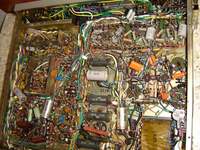-

pioneer
sx-110
     |
Pioneer
SX-110 was to be the receiver with the highest power, very
good parameters of the tuner and generally compete with
the Sansui 1000A in terms of parameters. Perhaps it was
successful, but the SX-110 models were sold many times
less than 1000A. The power amplifier worked on 7868 tubes
in a Push & Pull arrangement with adjustable bias,
delivering according to producer's total of 110 W of
musical power. The bias voltage was fixed, but there was a
regulation of the balance of this voltage. This was
facilitated by the fact that a 20 ohm resistor was placed
in the cathode circuits, which made it possible to measure
the lamp current. The tubes 7868 were were in a matter of
fact 7591 tunes with a different base - novar - similar to
noval but slightly larger diameter. The usual driver tubes
are 6AN8. The FM head operating in the 88-108 MHz range
contained three tubes - one 6CW4 nuvistor and two 6AQ8 /
ECC85, of which one ECC85 section worked in the AFC
(Automatic Frequency Control). There was, after the head,
a three-stage intermediate frequency amplifier (the Sansui
1000A and 500A had four stages). The next element of the
tuner was a stereo decoder on three tubes 6CG7, 6AQ8 /
ECC85 and 6AV6 / EBC91. The tuning indicator was a common
for Pioneer "magic eye" 6R-E13, and the MPX signal
was declared by a neon lamp. The receiver also had an AM
section for medium waves. The preamplifier was a standard
Pioneer design found in earlier models. One 12AX7 / ECC83
per channel was used to amplify the signals from the
turntables and the tape head. There was a balance and
volume control as well as a low-cut filter, high- cut
filter and loudness between the power amplifier and
another 12AX7. The bass and treble band adjustments as
well as the high-cut and low-cut filter preceded the
aforementioned ECC83. The voice and balance controls were
placed in one three-elements potentiometer, with one inner
axis controlling the volume and the other the balance.
Bass and treble adjustments were also made on double
coaxial potentiometers. This made it possible to
independently adjust each channel. On the front, apart
from the input switch, there was also a rotary switch for
changing channels, monophonization or selecting monophonic
L or R channels. The front panel was aluminum with a metal
frame around it. Prints of functions, switch and
adjustment in black paint on the front. Visually, the
receiver looked very nice and gave the impression of being
quite low. But it was an impression. Thanks to the use of
7868 tubes, the height of the structure was lowered, but
the SX-110 stood on very high feet, because the heat
emitted from the 110 W of power had to be dissipated. The
price for the lower height was the extension of the
equipment depth by nearly 5 cm compared to 1000A.
 |
Main page
Previous page
Contact
|